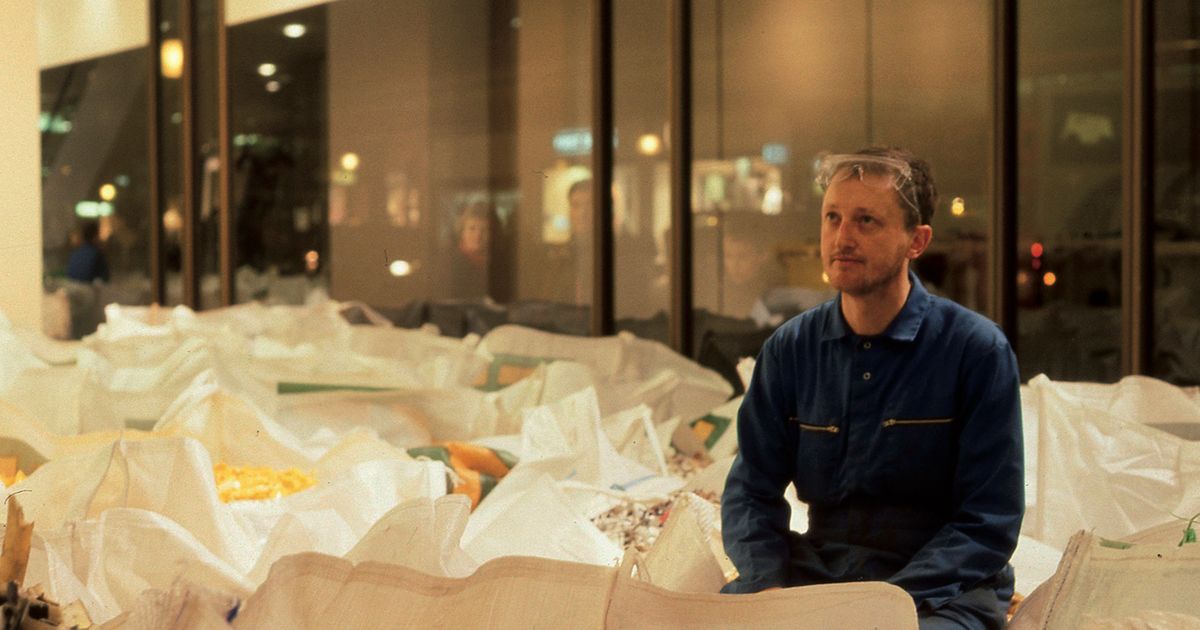ART WORLD NEWS
‘Like witnessing my own funeral’: Michael Landy’s possession-pulverising performance piece Break Down turns 20
Break Down was a turning point for Michael Landy’s career
© Michael Landy. Courtesy the artist, Thomas Dane Gallery and Artangel.
Today marks the twentieth anniversary of Break Down (2001), Michael Landy’s dramatic performance work that involved him pulverising all his worldly possessions—from a Saab 900 car to a single tea bag—leaving nothing but the clothes he was standing in. “It was like witnessing my own funeral,” Landy remembers. “The experience gave me some very dark moments, but liberating moments as well, thinking how I could literally take things apart, and doing it in front of people so they could express their own feelings about their belongings and what was valuable to them,” he adds. Two decades on, Break Down is recognised as one of the most significant works of recent British art and a watershed in Landy’s career. To mark this anniversary, tonight at 7pm Landy will be discussing the work, its themes and its consequences in a live online conversation with James Lingwood, the co-director of Art Angel, the organisation which commissioned the work.
Installation view, Michael Landy, Break Down (2001)
© Michael Landy. Courtesy the artist, Thomas Dane Gallery and Artangel. Photo: Hugo Glendinning
To accompany, Thomas Dane gallery is also mounting a display of archive materials, including videos, promotional material and a selection of photographs by Wolfgang Tillmans which document Break Down and are being exhibited for the first time. This will be on show on the lower level of 3 Duke Street when the gallery opens after lockdown. After its packed opening on 10 February 10, 2001, Break Down took place over two weeks in the former C&A department store on Oxford Street, during which Landy and a team of operatives systematically deconstructed, pulped and granulated everything he owned, having first meticulously inventoried every one of the 7,227 items. The process was carried out using a specially constructed facility designed by Landy and based on a material reclamation unit, with conveyor belts and special bays for each stage, from object to granule. At the end, the bagged-up remains, weighing 5.75 tonnes, were buried in a landfill site. “Some of it could have been recycled but I liked the idea of it all ending up in landfill and me ending up with nothing,” Landy says.
Michael Landy’s Scrapheap Services (1995)
© Michael Landy / Tate
He states that the idea for Break Down first came to him after he had sold Scrapheap Services (1995), an earlier work also based on disposal and human wastage, to the Tate. “It was the first time that I had some money, everything up until then had been a struggle,” he explains. “But now I had a Saab 900 car, some disposable income and a Richard James suit, and suddenly I thought, what was this struggle about? And it literally popped into my head to destroy all my worldly belongings.” Yet Landy is keen to stress that Break Down was not so much an act of personal sacrifice as an examination of consumerism and the power that possessions hold over us. “It was about me being one of many millions of consumers and how we create our biographies from all the stuff we own or possess. It was as much to do with people’s love of things and of different values and value systems.”
Installation view, Michael Landy, Break Down (2001)
© Michael Landy. Courtesy the artist, Thomas Dane Gallery and Artangel. Photo: Parisa Taghizadeh
It then took three years of intricate planning and a partnership with Artangel and the Times to bring Breakdown into being and to realise Landy’s ambition “to examine people’s motivations about consumerism by literally taking things apart to look at the guts and innards of how things are constructed”. But there was also a personal price to pay for such a draconian act. “I didn’t make any work for about a year afterwards—I found it very difficult to move forward creatively,” Landy reveals. When he did start making art again, it took the decidedly unspectacular form of minutely detailed etchings of common weeds. “I just have a dialogue with a plant,” he said at the time, “There are no phone calls, no making of lists; I have a plate and a metal needle that I scratch the surface with. I wanted to get back to actually making things.”
Michael Landy’s 2010 exhibition Art Bin installed in South London Gallery
Photo: Andy Stagg
But then in 2010, Landy instigated yet another epic act of creative destruction with his Art Bin, a giant container installed at South London Gallery into which he invited fellow artists and members of the public to jettison the artworks they considered to be creative failures. Hundreds, including Damien Hirst, Michael Craig Martin, Julian Opie and Landy himself did just that.Now, despite these various acts of catharsis, Landy admits that he has accumulated “much more stuff than when I did Break Down.” Which begs the question, would he ever be tempted to stage a repeat performance? He answers in the negative, but adds a caveat: “It would be good if someone would commission me to destroy all their worldly belongings, but not my own, I’d love to destroy all of Elton John’s worldly belongings—although that might take longer than two weeks.” You can sign up to watch tonight’s talk live via this link.
Source link













